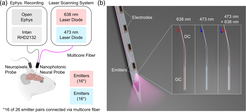Collaboration with the Allen Institute begins with the debut of new nanophotonic neural probes
A publication in SPIE Neurophotonics demonstrated a foundry-fabricated dual-color nanophotonic neural probe developed in collaboration between the Max Planck Institute of Microstructure Physics and the Allen Institute for Neural Dynamics.

Scientists from the Max Planck Institute of Microstructure Physics (MPI-MSP) (Halle, Germany) and the Allen Institute for Neural Dynamics (AIND) (Seattle, WA, USA) have unveiled a new implantable microchip-based tool for neuroscientists – dual-color nanophotonic neural probes that can both optically stimulate and electrically record brain activity for in vivo optogenetic experiments. The work, published open-access in SPIE Neurophotonics, is the first work to emerge from the collaboration between the research groups of Dr. Wesley Sacher (MPI-MSP) and Dr. Josh Siegle (AIND), with the goal of creating next-generation, implantable photonic probes for systems neuroscience research.
Fabricated on 200-mm-diameter wafers in a commercial silicon photonics foundry (Advanced Micro Foundry, Singapore), each probe integrates 52 grating-coupler emitters for cell-type–specific optogenetic stimulation using red or blue light. Additionally, the probes contain 26 titanium-nitride electrodes for simultaneously recording electrophysiological activity. The architecture of the photonic probe, which combines photonic spatial multiplexing and on-chip wavelength demultiplexing, pushes the emitter density beyond previous devices, while keeping the implantable shank (micro-needle portion of the microchip) only 70 µm wide – minimizing tissue damage during implantation. Using these devices, the team successfully modulated neural firing in mice expressing Channelrhodopsin-2 (blue-sensitive) or ChrimsonR (red-sensitive) opsins while recording evoked responses from brain regions such as the cortex and striatum.
Equipped with these devices (and more advanced generations under development), researchers will be able to optically probe the function of brain regions spanning several millimeters with greater spatial resolution. And by leveraging standard foundry (microchip factory) processes, the approach is also scalable: several hundred probes can be produced per wafer, paving the way for distribution of this new technology to neuroscientists en masse.












